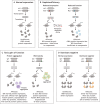Dominantly inherited muscle disorders: understanding their complexity and exploring therapeutic approaches
- PMID: 39501809
- PMCID: PMC11574355
- DOI: 10.1242/dmm.050720
Dominantly inherited muscle disorders: understanding their complexity and exploring therapeutic approaches
Abstract
Treatments for disabling and life-threatening hereditary muscle disorders are finally close to becoming a reality. Research has thus far focused primarily on recessive forms of muscle disease. The gene replacement strategies that are commonly employed for recessive, loss-of-function disorders are not readily translatable to most dominant myopathies owing to the presence of a normal chromosome in each nucleus, hindering the development of novel treatments for these dominant disorders. This is largely due to their complex, heterogeneous disease mechanisms that require unique therapeutic approaches. However, as viral and RNA interference-based therapies enter clinical use, key tools are now in place to develop treatments for dominantly inherited disorders of muscle. This article will review what is known about dominantly inherited disorders of muscle, specifically their genetic basis, how mutations lead to disease, and the pathomechanistic implications for therapeutic approaches.
Keywords: Dominant disease mechanisms; Dominant inheritance; Muscular dystrophy; Myopathy.
© 2024. Published by The Company of Biologists Ltd.
Conflict of interest statement
Competing interests The author is a co-inventor on patent US12043832B2.
Figures




Similar articles
-
Skeletal muscle alpha-actin diseases.Adv Exp Med Biol. 2008;642:15-27. doi: 10.1007/978-0-387-84847-1_2. Adv Exp Med Biol. 2008. PMID: 19181090
-
A heterozygous 21-bp deletion in CAPN3 causes dominantly inherited limb girdle muscular dystrophy.Brain. 2016 Aug;139(Pt 8):2154-63. doi: 10.1093/brain/aww133. Epub 2016 Jun 3. Brain. 2016. PMID: 27259757
-
Dominantly inherited myopathy with novel tubular aggregates containing 1-21 tubulofilamentous structures.Acta Neuropathol. 2001 Jul;102(1):27-35. doi: 10.1007/s004010000342. Acta Neuropathol. 2001. PMID: 11547948
-
Muscular dystrophies and other genetic myopathies.Neurol Clin. 2013 Nov;31(4):1009-29. doi: 10.1016/j.ncl.2013.04.004. Neurol Clin. 2013. PMID: 24176421 Review.
-
Overview of distal myopathies: from the clinical to the molecular.Neuromuscul Disord. 1998 Jun;8(5):309-16. doi: 10.1016/s0960-8966(98)00030-3. Neuromuscul Disord. 1998. PMID: 9673984 Review.
Cited by
-
Myofibrillar myopathy: towards a mechanism-based definition as a Z-disk-opathy.Curr Opin Neurol. 2025 Jun 10:10.1097/WCO.0000000000001397. doi: 10.1097/WCO.0000000000001397. Online ahead of print. Curr Opin Neurol. 2025. PMID: 40488240
-
Molecular genetics of J-domain protein-related chaperonopathies in skeletal muscle.J Hum Genet. 2025 Jul 22:10.1038/s10038-025-01372-8. doi: 10.1038/s10038-025-01372-8. Online ahead of print. J Hum Genet. 2025. PMID: 40696134 Free PMC article. Review.
References
-
- Abu-Baker, A., Kharma, N., Perreault, J., Grant, A., Shekarabi, M., Maios, C., Dona, M., Neri, C., Dion, P. A., Parker, A.et al. (2019). RNA-Based therapy utilizing oculopharyngeal muscular dystrophy transcript knockdown and replacement. Mol. Ther. Nucleic Acids 15, 12-25. 10.1016/j.omtn.2019.02.003 - DOI - PMC - PubMed
-
- Agrawal, P. B., Strickland, C. D., Midgett, C., Morales, A., Newburger, D. E., Poulos, M. A., Tomczak, K. K., Ryan, M. M., Iannaccone, S. T., Crawford, T. O.et al. (2004). Heterogeneity of nemaline myopathy cases with skeletal muscle α-actin gene mutations. Ann. Neurol. 56, 86-96. 10.1002/ana.20157 - DOI - PubMed
Publication types
MeSH terms
Grants and funding
LinkOut - more resources
Full Text Sources
Medical

